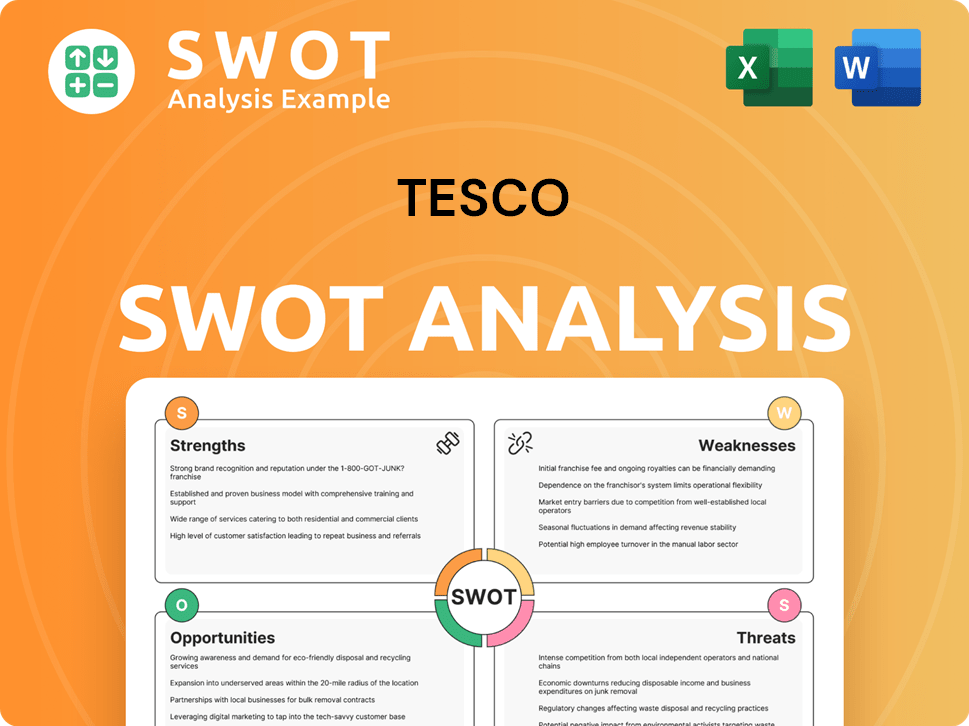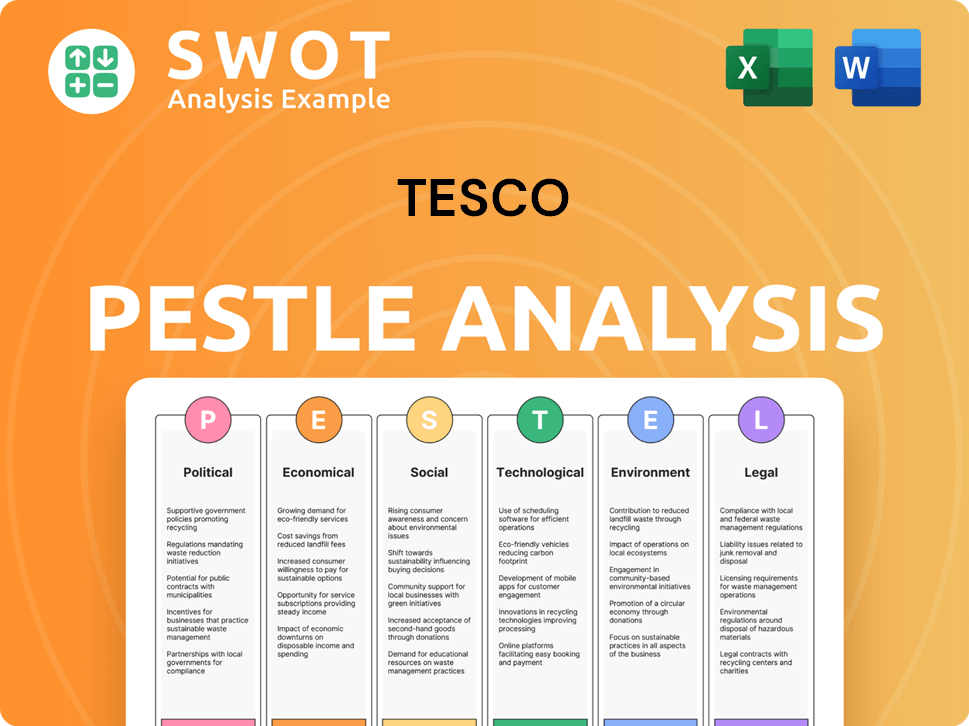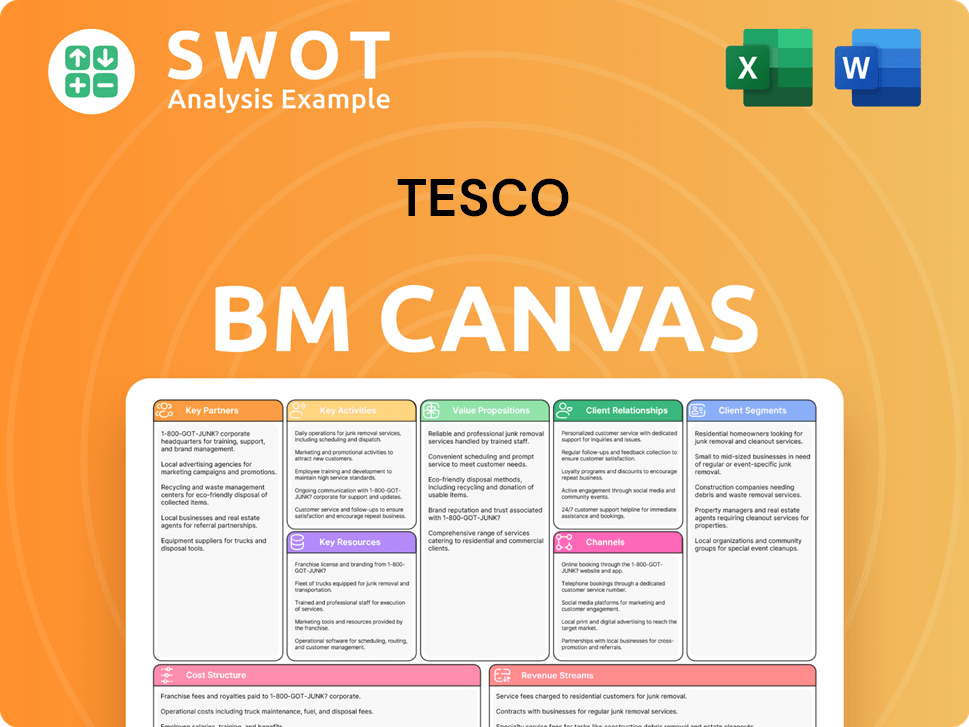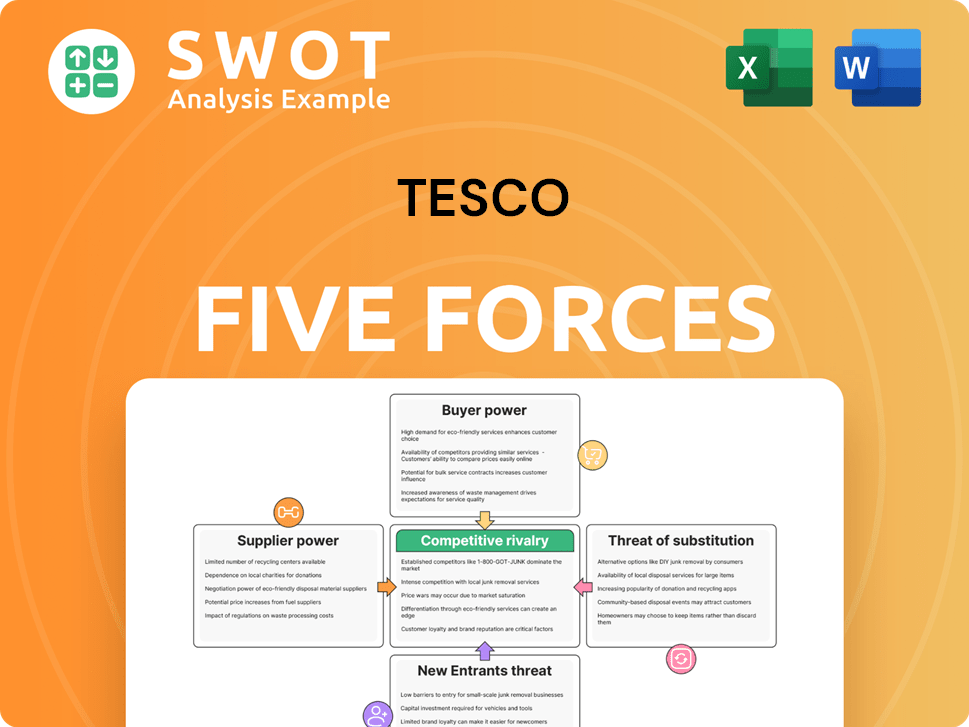Tesco Bundle
How Does Tesco Navigate the Grocery Wars?
The grocery retail sector is a battlefield, constantly reshaped by consumer demands and technological leaps. Tesco, a titan in this arena, has built a legacy on providing accessible, quality goods. But in a market brimming with rivals, how does Tesco maintain its edge and what strategies does it employ to thrive?

To truly understand Tesco's position, we must conduct a thorough Tesco SWOT Analysis. This deep dive into the Tesco competitive landscape will explore its Tesco competitors, offering a comprehensive Tesco market analysis within the dynamic Tesco industry. We'll dissect its Tesco business strategy within the competitive Tesco UK market, examining its strengths, weaknesses, and future outlook to provide actionable insights for investors and strategists alike.
Where Does Tesco’ Stand in the Current Market?
Tesco's core operations revolve around its extensive network of retail stores and online platforms, offering a wide array of products. The company's value proposition centers on providing customers with quality products at competitive prices, convenience through various store formats and online services, and a strong customer loyalty program. This approach aims to meet diverse consumer needs within the UK market and beyond.
The company's business strategy is built upon a multi-format approach, including large hypermarkets, supermarkets, and smaller convenience stores, alongside a robust online presence. This strategy allows Tesco to cater to different shopping preferences and geographic locations. Tesco's commitment to customer satisfaction, coupled with its operational efficiency, has solidified its position as a market leader in the grocery sector.
Tesco's market position is significantly influenced by its ability to adapt to changing consumer behaviors and economic conditions, as highlighted in this article on the Growth Strategy of Tesco. The company continuously invests in its supply chain, technology, and product offerings to maintain its competitive edge.
As of May 2024, Tesco held approximately a 27.6% share of the UK grocery market. This demonstrates its dominance in the Tesco UK market. This is a slight increase from the previous year, indicating continued success despite intense competition.
Tesco operates through various retail formats, including Tesco Extra, standard supermarkets, and smaller convenience stores such as Tesco Express and One Stop. This multi-format approach allows Tesco to cater to diverse customer needs across urban and suburban areas.
Tesco's primary product lines include food items, clothing, homeware, and health and beauty products. The company has invested in its budget-friendly 'Jack's' brand and premium 'Finest' range to appeal to a broad customer base and compete effectively within the Tesco competitive landscape.
For the fiscal year ending February 2024, Tesco reported a retail adjusted operating profit of £2.76 billion, a 10.9% increase year-on-year. This demonstrates strong financial health and operational efficiency, crucial for maintaining its competitive position.
Tesco's strategic initiatives include expanding its online grocery platform, enhancing its Clubcard loyalty program, and maintaining competitive pricing. These efforts aim to strengthen customer engagement and gain insights to improve its Tesco market analysis.
- Investment in digital transformation and online grocery services.
- Expansion of the Clubcard loyalty program to enhance customer engagement.
- Focus on competitive pricing to maintain market share against Tesco competitors.
- Continuous adaptation to changing consumer behaviors and market trends.
Tesco SWOT Analysis
- Complete SWOT Breakdown
- Fully Customizable
- Editable in Excel & Word
- Professional Formatting
- Investor-Ready Format

Who Are the Main Competitors Challenging Tesco?
Understanding the Revenue Streams & Business Model of Tesco is crucial for evaluating its position within the competitive landscape. The company faces a complex web of rivals across various retail formats and product categories. A detailed Tesco market analysis reveals the dynamics of its interactions with both direct and indirect competitors, shaping its strategic decisions and financial performance.
The Tesco competitive landscape is constantly evolving, influenced by shifts in consumer behavior, technological advancements, and economic conditions. This article explores the key players challenging the company, including established supermarkets, discounters, and online retailers. Analyzing these competitive pressures provides insights into the strategies the company employs to maintain and grow its market share.
The primary direct competitors for the company in the UK grocery market include Sainsbury's, Asda, and Morrisons. These supermarkets compete on price, product range, and convenience, targeting similar customer segments. They frequently engage in price wars and promotional campaigns to attract customers.
Aldi and Lidl have significantly disrupted the UK grocery market. They offer a limited range of products at significantly lower prices, appealing to budget-conscious consumers. Their aggressive expansion and market share gains have forced traditional supermarkets to adjust their strategies.
Ocado specializes in online grocery delivery and leverages advanced automation. It competes directly with the company in the online grocery segment. The growth of online shopping presents both opportunities and challenges for traditional retailers.
Indirect competitors include general merchandise retailers, convenience stores, and food service providers. These entities indirectly compete for consumer spending. The competitive landscape is further shaped by mergers and alliances within the industry.
The combined market share of Aldi and Lidl in the UK reached 17.6% as of May 2024, demonstrating their significant impact. This has led to increased price competition and a focus on value-oriented private label brands. The company's strategies must adapt to these shifts.
The company has responded to competitive pressures by re-evaluating pricing strategies and introducing more value-oriented private label brands. It also invests in technology to enhance its online presence and fulfillment capabilities. These efforts are crucial for maintaining competitiveness.
The Tesco industry faces constant change, with new players and technologies reshaping the market. The company's ability to adapt and innovate is critical for its long-term success. Understanding Tesco's market share compared to competitors is essential for evaluating its performance. The rise of discounters and online retailers necessitates continuous strategic adjustments. Analyzing Tesco's strengths and weaknesses analysis in relation to its rivals provides valuable insights into its competitive position. The company's future outlook depends on its ability to navigate these challenges effectively. The company's strategic initiatives to gain market share include a focus on customer loyalty programs, supply chain optimization, and international expansion. The impact of inflation on the company's competitive position and its sustainability efforts also play crucial roles in shaping its future. The use of technology and pricing strategies are key factors in its ability to compete effectively.
Several factors drive competition in the UK grocery market. These include pricing strategies, product range, store location and convenience, customer service, and marketing efforts. The company must excel in these areas to maintain its market share.
- Price: Competitive pricing is essential to attract and retain customers.
- Product Range: Offering a diverse and appealing product range is crucial.
- Convenience: Store locations, online ordering, and delivery options impact convenience.
- Customer Service: Providing excellent customer service builds loyalty.
- Marketing: Effective marketing campaigns create brand awareness and drive sales.
Tesco PESTLE Analysis
- Covers All 6 PESTLE Categories
- No Research Needed – Save Hours of Work
- Built by Experts, Trusted by Consultants
- Instant Download, Ready to Use
- 100% Editable, Fully Customizable

What Gives Tesco a Competitive Edge Over Its Rivals?
Analyzing the Marketing Strategy of Tesco reveals a company with significant competitive advantages. These strengths are rooted in its vast scale, strong brand recognition, and an extensive retail network. Furthermore, strategic investments in technology and a customer-centric approach, particularly through its loyalty program, have solidified its position in the
One of the key elements of
The company's brand equity, built over decades, is a significant asset. The Clubcard program, with over 20 million active users, provides invaluable customer data. This data enables personalized offers, targeted marketing, and informed product development. The Clubcard data-driven approach enhances customer retention and provides a competitive edge. This data-driven approach enhances customer retention and provides a competitive edge.
Tesco's size allows for favorable supplier terms and cost efficiencies. This results in competitive pricing and enhanced profitability. The extensive private label range boosts profit margins.
Strong brand recognition and customer trust are key. The Clubcard program provides valuable customer data. This data enables personalized offers and informed product development.
An extensive network of stores and a robust online delivery infrastructure ensure widespread accessibility. Customers can shop in-store, online for delivery, or via click-and-collect. Online sales grew by 11.3% in the fiscal year ending February 2024.
Direct sourcing and efficient logistics contribute to product freshness and availability. Technology enhances operational efficiencies, from inventory management to checkout processes. These factors are crucial for
Tesco's competitive advantages are multifaceted and include economies of scale, strong brand equity, an extensive retail network, and technological investments. These factors enable the company to offer competitive pricing, build customer loyalty, and adapt to evolving consumer demands.
- Economies of scale leading to cost efficiencies.
- Strong brand recognition and customer loyalty programs.
- Extensive retail network and omnichannel presence.
- Investments in technology and data-driven decision-making.
Tesco Business Model Canvas
- Complete 9-Block Business Model Canvas
- Effortlessly Communicate Your Business Strategy
- Investor-Ready BMC Format
- 100% Editable and Customizable
- Clear and Structured Layout

What Industry Trends Are Reshaping Tesco’s Competitive Landscape?
The grocery retail sector is currently undergoing significant transformation, impacting the competitive landscape of companies like Tesco. Key trends include the rise of e-commerce, the integration of AI and automation, and a growing emphasis on sustainability. These factors present both opportunities and challenges for Tesco, influencing its strategic decisions and market position. This analysis will explore industry dynamics, potential future challenges, and growth opportunities for Tesco, providing a comprehensive view of its competitive environment.
Understanding the Tesco competitive landscape requires a look at its industry position, the risks it faces, and its future outlook. The company operates in a highly competitive market, facing pressure from both traditional rivals and emerging players. Its ability to adapt to changing consumer preferences, leverage technology, and manage economic fluctuations will be crucial for its continued success. A detailed Target Market of Tesco analysis can further illuminate its strategic focus and consumer base.
The Tesco industry is shaped by several key trends. E-commerce and online grocery shopping continue to grow, with consumers seeking convenience and broader product selections. Sustainability and ethical sourcing are also becoming increasingly important to consumers. AI and data analytics are being used to personalize marketing and optimize operations.
Tesco faces challenges from discounters like Aldi and Lidl, who are expanding their market share. Economic downturns and inflation can also impact consumer spending. Regulatory changes, particularly regarding sustainability and food labeling, add complexity and cost. Adapting to changing consumer preferences remains a constant challenge.
Significant growth opportunities exist in expanding online platforms and forging strategic partnerships. Innovation in product lines, particularly in convenience foods and sustainable options, can drive growth. Tesco can also leverage its Clubcard loyalty program to strengthen customer relationships. Emerging markets present additional potential.
Tesco is investing in digital capabilities and optimizing its store estate to remain competitive. Enhancing private label offerings and focusing on the Clubcard loyalty program are key strategies. The company must continuously adapt to evolving trends and maintain a strong focus on customer satisfaction to succeed in the competitive landscape.
Tesco’s business strategy involves several key initiatives to maintain its market position. These include a strong focus on online grocery sales, with investments in delivery infrastructure. The company is also enhancing its private label offerings to provide value to customers. Additionally, Tesco is leveraging its Clubcard loyalty program to deepen customer relationships.
- Digital Transformation: Investing in e-commerce platforms and delivery services to meet changing consumer demands.
- Private Label Expansion: Expanding its range of own-brand products to offer competitive pricing and increase profit margins.
- Customer Loyalty: Strengthening its Clubcard program to encourage repeat purchases and gather valuable customer data.
- Sustainability Initiatives: Reducing plastic packaging and promoting sustainable sourcing to meet consumer demand.
Tesco Porter's Five Forces Analysis
- Covers All 5 Competitive Forces in Detail
- Structured for Consultants, Students, and Founders
- 100% Editable in Microsoft Word & Excel
- Instant Digital Download – Use Immediately
- Compatible with Mac & PC – Fully Unlocked

Related Blogs
- What are Mission Vision & Core Values of Tesco Company?
- What is Growth Strategy and Future Prospects of Tesco Company?
- How Does Tesco Company Work?
- What is Sales and Marketing Strategy of Tesco Company?
- What is Brief History of Tesco Company?
- Who Owns Tesco Company?
- What is Customer Demographics and Target Market of Tesco Company?
Disclaimer
All information, articles, and product details provided on this website are for general informational and educational purposes only. We do not claim any ownership over, nor do we intend to infringe upon, any trademarks, copyrights, logos, brand names, or other intellectual property mentioned or depicted on this site. Such intellectual property remains the property of its respective owners, and any references here are made solely for identification or informational purposes, without implying any affiliation, endorsement, or partnership.
We make no representations or warranties, express or implied, regarding the accuracy, completeness, or suitability of any content or products presented. Nothing on this website should be construed as legal, tax, investment, financial, medical, or other professional advice. In addition, no part of this site—including articles or product references—constitutes a solicitation, recommendation, endorsement, advertisement, or offer to buy or sell any securities, franchises, or other financial instruments, particularly in jurisdictions where such activity would be unlawful.
All content is of a general nature and may not address the specific circumstances of any individual or entity. It is not a substitute for professional advice or services. Any actions you take based on the information provided here are strictly at your own risk. You accept full responsibility for any decisions or outcomes arising from your use of this website and agree to release us from any liability in connection with your use of, or reliance upon, the content or products found herein.